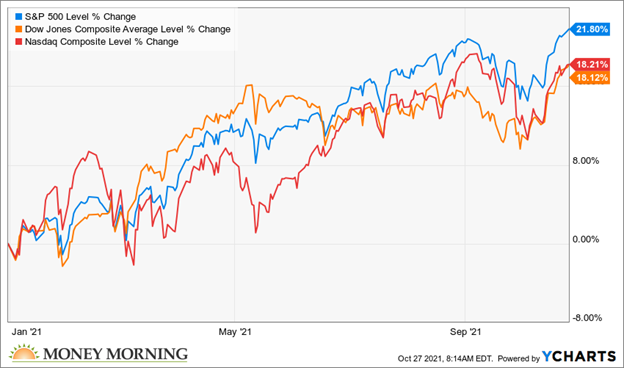The Biggest Threat to the Market is Here and No-One Seems to Care… But You Should
Shah Gilani|October 28, 2021
We are in the throes of a spectacular bull market.
Since it started stampeding back in 2009, the S&P 500 has risen 551%, while the DOW and Nasdaq have risen even higher. And they are still climbing.
Which, on its face, is great for us – but we need to be cautious. There are many threats to a bull market, but there is one singular, systemic threat that everyone should be afraid of: rising interest rates.
Rapidly rising rates shook investors and the market back in January when the Treasury 10-year note surged from 0.98% to 1.74% by the end of March. Alongside that 78% jump, the DOW saw two scary drops of almost 5% each over the same three months.
At its March peak, the markets took a hit, but rates quickly fell back down, clearing the way for them to break into even higher highs.
Since then, many became too comfortable, even complacent, as the bull raged on and investors pulled in record gains. So much so that they haven’t even realized that the same rates that had them so shaken in January are rising again, and this time they should be scared.
And us? We need to prepare for the opportunity of a lifetime.
Today, I’m giving you all you need and more to invest your way through what comes next.
Pockets Lined with Dust
We’ve enjoyed record-low interest rates here in the US for years because of government manipulation. The Federal Reserve orchestrated this with zero interest rate policies for big banks, super lower rates for borrowing, and successive rounds of “quantitative easing.”
This created a stock boom. With the markets continually propped up by the government, institutional investors borrowed more and more money to buy more and more stocks. The end result, stock prices shot have through the roof and continue to climb.
But Houston, we have a problem. A lot of the money going into the market is nothing but fairy dust and has been for nearly 13 years.
The Federal Reserve’s assets (a convenient euphemism for how much money it prints and pumps into banks and the economy) amounted to $909.98 billion back in 2008. In response to the Financial Crisis, the Fed cranked up their printing presses to produce assets up to $4.5 trillion by 2014, a number they maintained for many years until the next big economic crisis.
As of October 2021, the Fed’s sitting on $8.56 trillion in so-called assets.
That means the Fed printed $4.4 trillion, more than doubling the assets on its balance sheet since the pandemic started. On paper, the Fed did this to battle deflation – something we never really experienced – by targeting a 2% inflation rate.
Well, be careful what you wish for. That inflation is here. And it’s a lot higher than transient bumps up to 2% in terms of CPI (Consumer Price Index) or the Fed’s preferred PCE index (Personal Consumption Expenditure).
To save face, the Fed is going to cut down it’s spending on assets (which currently costs them $120 billion every month). That will reduce how much money they need to print to pay for those assets.
But more importantly, it will lower the amount of money flowing into banks and the economy, so investors are going to have less money to invest with.
And according to Fed Fund futures, the Fed will start raising interest rates late next year – all the while inflation is (and will continue to be) heating up.
In fact, the Fed has finally admitted that the “transitory” inflation it saw could be structure, something I’ve been saying all along. In short, that means this inflation will be a part of the economic landscape for a long time.
Which, in turn, makes it a great opportunity for those of us smart enough to play it now.
The Rate Rising Play
Despite wishful thinking about the bond short squeeze traders will bring rates back down to earth, inflation isn’t faltering.
The Fed’s about to start tapering. Workers are demanding (and getting) higher wages, which will translate to greater demand and greater pressure on prices. And, eventually, the Fed will have to start raising rates.
This will create the fiercest matador, the one capable of killing this bull market.
For now, though, rates aren’t rising fast enough to take down the bull. Stocks can still go higher, especially retail stocks as we enter this holiday shopping season. But be wary this year. The dividing line between the winners and losers will be wide, which is why I’ve put together a “who’s who” of retail stocks.
You’ll get four today by clicking here and six more when I go live this Friday at 2:00 pm EST. I hope to see you there.
Across your portfolio, raise your profit targets, raise your stops, and prepare to get out of stocks when the bull stumbles. Rapidly rising rates will stop this market in its tracks and there are trillions of dollars on the table for the taking.
And then, during the initial selloff, use that opportunity to break back in and invest in stocks that will rise along with climbing rates, like…
- ProShares Equities for Rising Rates ETF (EQRR),
- Bank of America Corp. (BAC),
- Schlumberger N.V. (SLB), and
- International Paper (IP).
That last one even pays you a juicy 3.5% dividend yield as you watch it appreciate.
Go get ’em,
Shah
P.S. In case you haven’t heard, I’m hosting a special event tomorrow at 2:00pm EST. Click here to RSVP and grab a few free plays while you’re at it. Hope to see you there.


